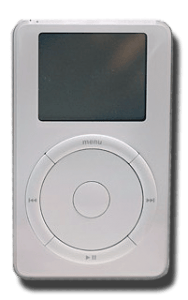Earlier I posted a list of sources for math data to use with your gifted students. Here’s an example of how my class will be practicing percentages using some real data (inspired by the amazing math work by Dan Meyer).
The Inspiration
The post “Should I Have Bought That Apple Product” provides some outstanding information regarding the price of Apple products and the increase in Apple stock. For example, if you bought an original iPhone in January of 2007, you dropped $499. If you bought Apple stock instead, that stock would be worth $1,460 or an increase of about 293%!
The Hook
Again, borrowing from Dan Meyer’s rules for creating an intriguing and challenging problem, I begin with a visual of the original iPod (courtesy of Wikipedia) and throw out a bunch of questions to get the class talking.

First Generation iPod
- “What is this thing?” (first generation iPod)
- “How’s it different from the one you have now?” (black and white screen, buttons along the wheel, smaller hard drive, etc)
- “When did this iPod come out?” (October 23, 2001)
- “How much did it cost?” ($499)
Pose The Big Question
“Let’s say that instead of buying this iPod, you spent the same amount of money on Apple stock. How much would that stock be worth now?”
I then open up a round of inquiry. During this time, students get thirty seconds to consider what information they need. Then I answer as many of those questions as I feel necessary. In this case, I’ll answer the following questions (oh, and I try to answer them all visually – I used screenshots from Yahoo’s finance webpage for example):
- How much did the iPod cost when it came out?
- How much did Apple stock cost on that day?
- How much is Apple stock worth now?
The Work
I then allow students to partner up and take a crack at the big question. Why partners?
- Collaboration is awesome.
- But too many cooks in the kitchen leads to chit chat and free-riders.
- I also leave the solo option available for reasons explained here.
- This frees me up to sit with students who I identified earlier as lacking pieces of the base skill.
I’m also emphasizing organization of work in these activities. If their work requires any interpretation on my part, I send them back to relabel, restructure, and reorganize. Students are using the depth and complexity.
The Conclusion
We wrap it back up at the end and see who got the closest to the correct percentage. I’ll ask for some of the 6th grade skills students used to answer the question. We talk through their thinking a bunch too.
It’s always fun to leave them with a question (perhaps an assignment for home?). In this case, I uncovered an ebay auction selling a first generation iPod (new in box!). It sold for $325. Students then determined the percent that they would have lost by selling the iPod. Students could also investigate the percent difference between the stock option and the iPod’s
